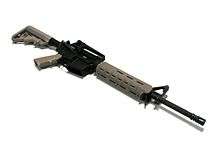M-LOK
M-Lok is a free licensed[1] accessory mounting system developed by Magpul Industries that allows for direct attachment to negative space mounting points. It is a competing standard to Keymod in regards of replacing the MIL-STD-1913 picatinny rail in some applications. Compared to the picatinny rail system, M-LOK and KeyMod enables the user to have a slimmer and smoother handguard with accessories mounted only where needed, whereas a picatinny handguards typically will have picatinny rail slots for its whole length resulting in a larger handguard diameter with sharp corners.
The M-LOK system can be seen as a further development of the Magpul MOE slot, but the two are not compatible. Newer M-LOK accessories can be used on older MOE slotted handguards if an adapter plate is used, however there is no adapter available for using older MOE slotted accessories on newer M-LOK handguards.
History
A prototype of the MOE slot was revealed by Magpul in late 2007 together with their Masada Concept Rifle (which would later be known as the Adaptive Combat Rifle). The MOE slot system was released by Magpul in 2009 as a feature on their MOE handguards, and at the same time compatible accessories such as picatinny rail sections, direct MOE mounted light mounts, grips, bipod studs, etc. were released.
The MOE slot standard was never officially released, and a drawback to the system was that the rear side of the panel had to be accessed in order to mount an accessories, limiting its application (the system could for instance not be used on free float handguards). Also, depending on the accessory item, the spacing increments between the MOE slots were not small or uniform enough to adjust the desired placement of accessories.
Acknowledging the MOE slot systems shortcomings, Magpul drafted M-LOK as a new and improved mounting standard which was released in 2014 replacing the existing MOE slot. The M-LOK rail specification included metric dimensions instead of imperial, and utilizes a T-slot nut with a thread-locking fluid making it suited for applications such as free floated handguards. The MOE slot system on the other hand uses a weld nut which has to be placed manually on the inside of the handguard before mounting, making the slot system unsuited for applications such as free floated handguards.
Licensing

While M-LOK is free-licensed, it is not open source, and thus manufacturers must acquire a license from Magpul before making products using the M-LOK standard. Magpul claims this gives them more control in assuring that all M-LOK products are made to specifications ensuring compatibility. Program participation is open to any interested manufacturer.
Technical specifications
Rail specifications
The slot dimensions (used on handguards, etc.) are available on the web.[2] Slots have (like the picatinny rail) 20 mm length (see metric system), and accessories can be mounted either within a slot or bridging between slots, making it possible to adjust the position of accessories in smaller intervals than the length of the slot. The slots on an M-Lok handguard are approximately 32 mm long and 7 mm wide.[3]
Attachment specifications
The half-turn T-slot nut attachment screws have imperial #10-24 threads (0.19"/ 4.8 mm major thread diameter) and a socket head button which uses a 1/8" hex key (≈ 3 mm). The closest metric equivalent, which is preferred for military use, is an M5 thread (5 mm major thread diameter) and a socket head button which uses a 3 mm hex key.
While screw and slot dimensions are available on the web, the T-Nut dimensions are currently under review by the US State Department to determine whether it should be regulated by ITAR, and until it is clarified drawings are only available to US citizens.
See also
- Rail Integration System, generic term for a system for attaching accessories to small firearms
- Weaver rail mount, early system used for scope mounts, still has some popularity in the civilian market
- UIT rail, an older standard used for mounting slings particularly on competition firearms
- Sling swivel, older standard used for mounting slings, particularly on hunting firearms
- Picatinny rail (MIL-STD-1913), improved and standardzied version of the Weaver mount. Used for both for scope mounts, and for accessories (such as extra sling mounts, vertical grips, bipods etc.) Major popularity in the civilian market.
- NATO Accessory Rail- further development from the MIL-STD-1913
- KeyMod - competing standard open standard design to M-LOK for mounting accessories
References
- ↑ Magpul Industries - M-LOK
- ↑ Magpul Industries - M-LOK DESCRIPTION AND FAQ DOCUMENT
- ↑ magpul.com - M-LOK 2015 FAQs
